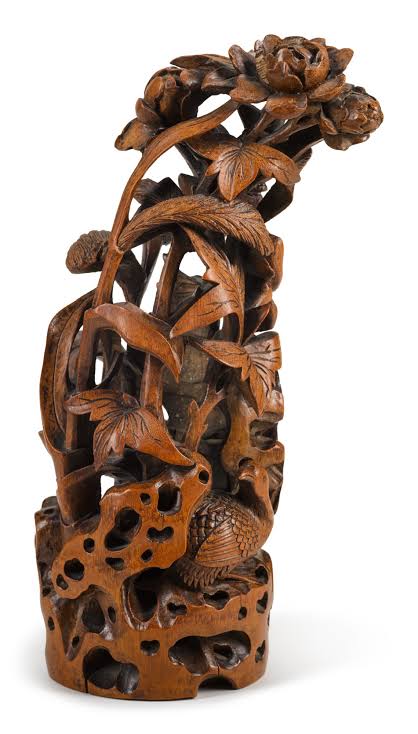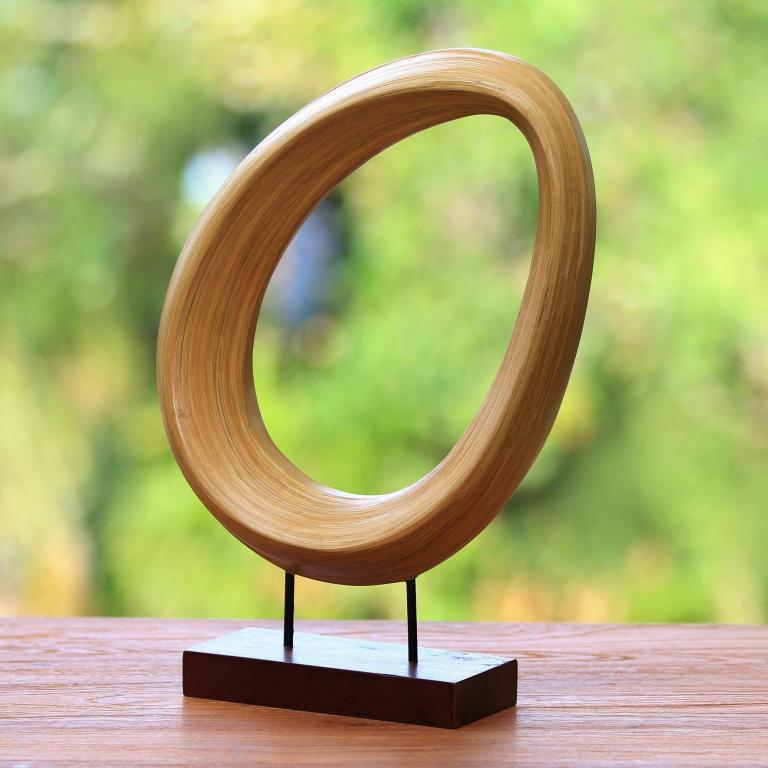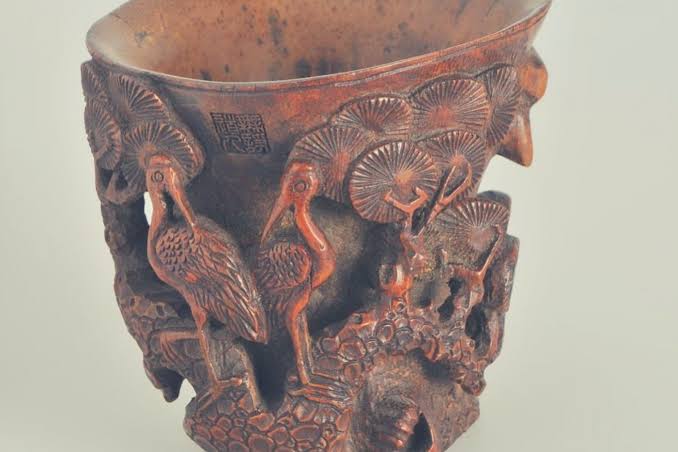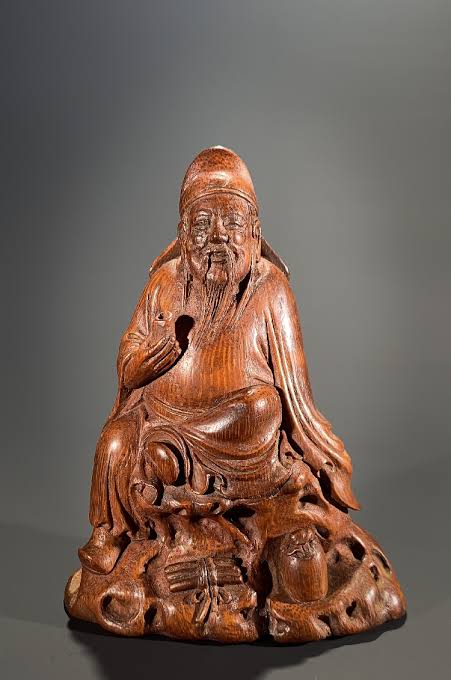Bamboo carving
12 min readBamboo carving, also known as bamboo sculpture, refers to all kinds of display articles where pattern or characters are carved on articles made of bamboo or in bamboo root. China is the first country in the world using bamboo wares. The bamboo production or living tools used in the ancient China were with ornaments for aesthetic purpose just like jade, stone, bone and wood wares. However, bamboo ware was easily broken and difficult to preserve. The earliest bamboo ware found is a painted bamboo spoon unearthed in the No. 1 Han Dynasty Tombs at Mawangdui, Changsha With dragon design and plaits, and carved in relief and openwork, the bamboo spoon was very beautiful and precious

Liuqing bamboo carving(carving a design by scraping off or leaving skin of bamboo) has become mature in Tang Dynasty, which we can refer to an expression trace is as if made by powder carving”in the anecdotes of pictures by Guo ruoxu Shakuhachi, a bamboo music instrument collected in shosoin of japan from tang Dynasty is the evidence in kind. The Shakuhachi was carved in low relief using Liuqing technique, on which there were beautiful women, trees, floors, birds and butterflies The pattern is of very Tang Dynasty style. Liuqing is to carve a design leaving the skin of bamboo, and the design will turn from green into white after drying, which resembles the expression trace is as if made by powder carving Zhan Cheng was a famous bamboo carver in Song Dynasty. We can find the recordof his bamboo bird cage in the Notes Made While resting from Farm Work by tao Zongyi, a writer from late Yuan and early Ming Dynasty. It says in the Notes that his amboo carving artworks about palaces, figures, landscape, flowers and trees, and birds were not only remarkably true to life and also very exquisite and vivid. Fragment of bamboo carving from Western Xia Regime was once unearthed in an imperial mausoleum in Ningxia. The figures in relief and design in intaglio show elaborate carving techniques; however the place of origin is yet to be determined Bamboo carving became a special craft after the mid-Ming Dynasty. Only a few culturally-literate craftsmen devoted themselves to the bamboo carving at the very beginning. Famous carvers in the early stage did not specialize in bamboo carving, but also carved on ivory, rhinoceros horn, rosewood and other materials. Later, as the bamboo was cheap and easily acquired and due to the craftsmanship passing from father to son, or from master to apprentice or imitation, more and more craftsmen engaged in bamboo carving and made it a specialty, and there are many artworks handed down from the ancient times. Although bamboos were abundant and easy to acquire, higher requirements were raised for bamboo carving.

To compete against expensive ivory and rosewood carving bamboo carving needs to have rich themes and exquisite techniques, and different carving techniques have to be applied as applicable only in this way can they show their artistic value Landscape-and-pavilion-design bamboo-carving brush pot with a seal of Zhang Xihuang of the Ming Dynasty, 10.3cm in height, carved smoothly with neat image, presenting a far-reaching conception The bamboo carving saw a rapid development after the jiajing period of ming Dynasty(1522-1566) Lots of famous bamboo carvers emerged one after another, but most of them came from Jiading(now Jiading, Shanghai) and Jinling (now Nanjing Jiangsu), Jiangsu Province. Zhu He, Zhu Ying, Zhu Zhizheng(grandfather, son and grandson), experts in poems and essays, painting and calligraphy, were the representatives of bamboo carving of Jiading school and honored as three zhu inJiading. They were very good at carving deeply, in openwork or in the round and formed their own”high, deep and open”style. Zhu He, the originator of bamboo carving of Jiading School, styled himself as Songlin, was apt to painting and calligraphy, and seal script. He always applied the calligraphy into his carving and pushed forward the development of bamboo carving in high relief. Unfortunately, his artworks left behind are very few due to the ages all his artworks handed down andwith autograph are fakes. The authentic work of Zhu He now found is the zhu He penContainer stored in Nanjing Museum. Pu Cheng, styled himself as Zhongqian, was the originator of bamboo carving of Jinling School. The bamboo carving of Jinling School was mainly featured by lowness and simpleness. Though the carving was not deep, the layers presented. They were skilled in carving on the twisted bamboo root along its natural shape. The carvers of Jinling School were also experts in carving calligraphy on bamboo, and their artworks were full of literate tinges. Except for the Zhu’s Carving and Pu’s Carving, there was also a Zhang’s Carving specialized in Liuqing in Ming Dynasty, and Zhang Zonglve was the representative figure. The way of liuqing in Zhang’s Carving either leaving the entire skin of bamboo, or leaving as much as it can or leaving as less as it can, variable in the depth and shade Bamboo carving technique made progress at Qing Dynasty. At the earlier stage of Qing Dynasty, the remarkable influential in bamboo carving includes Wu Zhifan, Feng Xilu, Zhou hao, Pan Xifeng etc. as a representative of bamboo carving of jiading School after the”Three Zhu, Wu Zhifan was skillful in all kinds of carving technique carving in the stereoscopic round or in relief, deep or low. Feng Xilu, also a famous carver of Jiading School, was particularly good at carving in the round, and his artworks were very novel and newfangled in shape. Zhou Hao, a townsman and contemporary of Feng Xilu, was a bit younger than Feng Zhou was very talented in drawing landscapes, figures, flowers and plants. As bamboo carver and also a painter, he was different from those bamboo carvers after the era of three zhu “Zhou was best known for not only his talent in various kinds of carving technique and master of many themes, but also for that he was the first to introduce the southern school painting into bamboo carving, which has a far-reaching influence. Zhou’s artworks were much better both in carving technique and painting than those bamboo carvings about landscapes at the late stage of Qing Dynasty as the latter did not pursue for fine carving technique but for the sentiment, so their artworks were less valuable. Pan Xifeng, born in Zhejiang but grew up in Yangzhou, was once praised by Zheng Banqiao as the “greatest bamboo carver after Pu Cheng”and accordingly classified into Jinling School. His bamboo carving was similar to Pu Cheng, low and carved in the round, and splendid in Liuqing. His artworks were mostly about the basics
Many bamboo carvers can be written into the history at late Qing Dynasty, but very a few can be claimed as a great master. Plenty of bamboo carvers intended to reflect sentiment on bamboo however seldom could master both carving and painting, so the carvers always turned to painters for painting. Unfortunately, thepainter could paint on the surface of bamboo only and for once, because it would be unrealistic to request the painter to paint once again after the carving it is therefore the carving at that time was confined to be low and incised or in intaglio this trend resulted in the change in the style of the age. Carving in low relief was not common to see, while those exquisite and fine carvings in high relief openwork and in the round were very rare the change of technique also made impact on the types of bamboocarving Wares carved in the round once very popular, such as pen container andincense tube carved in high relief and openwork, were decreasing gradually. Oncontrary, armrests and framework of fan carved in low on the surface of bamboo became prevalent. At late Qing Dynasty, Jiasu Jiading School, well known for its deep and high relief carving, was on the wane, and bamboo carving of Zhejiang school was on the upgrade, which managed to reflect painting, calligraphy and sentiment b carving traces and usually applied the incised carving technique

Bamboo joint carving is the representative of bamboo carving. Many beautifu artworks are handed down from generations to make a splendid artwork of bamboo joint carving, the bamboo joint needs to be processed into an armrest, pen container, incense tube, tea caddy or other wares first, and then the carver start carving on the wares in deep or low relief or openwork. An armrest is a support of one ‘s arm when riting, often made by bamboo. a bamboo armrest, usually flat and strip-like, was a common type of stationery and a refined play thing popular among men of letters During the interval of writing one could hold the armrest and play it, and it would become glossy after a long time. Number of famous bamboo carvers in Ming Dynasty and Qing Dynasty were also good at calligraphy and painting. With the green skin of bamboo as the drawing paper, they enriched the themes and techniques for bamboo carving with the art of painting and calligraphy, which bestows the bamboo carving with the charming of painting and calligraphy
Bamboo-root-carving steelyard box of the former Republic of China period, 398cm in length, made up of strong bamboo roots. Dengzi, also called Deng steelyard, is a small precise weighing instrument specially used to weigh gold, silver, expensive drugs and spice in the ancient time. Due to its fine manufacturing, it is Bamboo carving thrives mostly in Shanghai, Jiangsu, Zhejiang, Hunan, Guangdong and Sichuan in the modern time of china the bamboo carving of jiangnan school centers on Liuqing”technique, and stresses the combination of bamboo carving with the art of painting and calligraphy artistically, with an aim to change the low and simple carving style in late Qing Dynasty. For example, Qi Baishi, a great modern painter with carpenter background created a series of artworks carved in the round in relief or in openwork with bamboo as the theme and based on folk life in late 1990
The carving was smooth, vivid and fresh. Zhang Zhiyu, a great master of metal and stone seal cutting, was a calligrapher and painter, and also a bamboo carver. He is best at carving calligraphy and painting of great master on the framework of fan, and is honored as the first master hand of bamboo carving in modern Beijing. his original carving technique, liuqing carving on sand, is to carve calligraphy and painting in relief on the framework of fan with green skin of bamboo from the south and then shovel flat the sand, pick out the shape of sand with sharp knife and then polish with waxing The base part is of yellow sand shape, and the scene is very elegant and beautiful in light green
The reason why Chinese bamboo carving becomes a systematic independent art form is mainly due to the participation of and promotion by men of letters. Material, technique and design are highly coordinated; bamboo carving makes a perfect integration of the skill of artisans with the art of intelligentsia with its wide inclusivity and extraordinary artistic performance. Bamboo carving techniques handed down from ancient times include Liuqing, Tiehuang(attaching the yellow inner skin of bamboo to the base), circular carving and inlay
Shepherd Boy and Cattle,with an overall height of 21.5cm and a base diameter of 17cm,painted by Q Baishi in 1894.The first bamboo joint is used as rounded foundation and the side carving is incised in regular script.There is a large buffalo and a small buffalo on it.Two shepherd boys on the back of large buffalo jointly play a branch and one shepherd boy on the small buffalo raises the rice ear to drive the buffalo
Buddha sitting on the lotus, a Zhejiang Xiangshan bamboo-root carving, 80cm in height, created by Zheng Baogen in 2009. It adopts the craftsmanship based on materials and takes advantages of its original shape Based on naturally dense bamboo roots, Buddha standing on the lotus smoothly carved is set off Liuqing, dated back to Tang Dynasty, is to keep the green skin of bamboo as the design and to scrape off the surface beyond the design to expose the light yellow bamboo flesh which is used as the base when the bamboo dries up its skin turns from green to white, and into light yellow one or two years after the carving, and remains almost the same since then however the bamboo flesh turns into dark yellow from light yellow and red purple from dark yellow; its color gradually becomes dark and finally looks like amber the bamboo would become as smooth as jade if caressed often as time lapses the bamboo skin and bamboo flesh show a remarkable difference in color, and the design becomes increasingly noticeable Zhuhuang refers to the yellow inner skin of bamboo, as bright and glossy as ivory Tiehuang technique usually uses big mao bamboo as materials. The fresh yellow inner skin pieces were boiled in water, dried up and made flat, and then attached to thewooden base to take shape boxwood is a superior material for the base as its color and luster are similar to Zhuhuang and it has fine and smooth texture tiehuang surface could be left smooth and plain, or carved with design However tiehuang can only undergo low carving as it is very thin For the need of dermatoglyphic pattern, some ware has to attach two or three layers of zhuhuang so that all kinds of patternare closely linked as if they were natural. Since the mid-Qing Dynasty, Shanghang of Fujian Province, Jiading of Jiangsu Province, Huangyang of Zhejiang province Shaoyang of Hunan Province and Jiang’ an of Sichuan Province were famous for its tiehuang artworks The bamboo is cylinder-shaped, and tiehuang uses wood as the base In this way there will be no limit on the shape and wares of various shapes car be made, which helps increase the use value. the tiehuang artworks collected in the Palace Museum are mainly created during the reign of Emperor Qianglong. The craftsmanship is so fine and exquisite, and the techniques are so diversified and complicated that none of tiehuang artworks from the folk can be compared with in modern time, tiehuang artisan can choose whatever fits to develop a tiehuang artwork
Circular carving mainly takes bamboo root as material. An artful or primitively simple or exquisite display article will be made by designing in accordance with the natural shape of the bamboo root and a slight change by carving. The most well known carver of this kind in Qing Dynasty was the Feng family, an aristocratic family of bamboo carving, especially Feng Xilu. They inherited the circular carving technique from the Zhu’s, and used bamboo root as raw material to imitate the reality and life in carving their artworks were famous for its novel shape and vividness Zhu ‘ s bamboo carvings were mainly on wares, while the Feng,s bamboo carvings were more into figures carving, and once specially created bamboo root carvings for the imperial. The bamboo root carving is to carve along the natural shape of the root, unique, natura and elegant, very popular among the men of letters. the artworks of this kind usually were given away as gift. a clever combination of the beauty of nature and human design is the unique creation philosophy for bamboo root carving also a reflection of Chinese traditional aesthetics in bamboo carving. An important feature of modern bamboo root carving is to carve partially instead of the entire To create a sense of depth for bamboo/wood carving, inlay technique can be applied Materials of different textures and colors and cluster form pattern through inlaying, or various kinds of materials, such as jade, stone, bamboo, wood and bone, are inlaid in one artwork to create a”one-hundred-precious-material inlay. Among the bamboo carvings handed down, there is one bamboo carving artwork that imitates the look of a bronze ware the classic shape of other bronze wares such as Ding(a cooking vessel), You, Zun(both are wine vessels) and kettle, can also be imitated. Either adding handle or chute, so many great ideas about carving were for the imperial household of Qing dynasty and can be classified into one kind de created due to the fine carving craftsmanship. the artworks of this kind were ma The modern bamboo carving is widely applied because of its rich expressive subjects By means of bamboo carving it is able to make refined scholar wares such as water pot, penholder, pen rack, pen container, armrest, paper weight and framework of fan, or practical and good-looking wares of everyday use like basket, box, kettle and
cup. The materials can be obtained locally and made best use of. Figures, animals, flowers and plants in circular carving, openwork carving or relief carving, as modern artworks, lay emphasis on the expression of thought and aesthetics, and most of them have their own style. Tales of Bamboo Carving by Jin Xiya, a great modern bamboo carver and edited for publication by Wang shixiang, a famous cultural relic connoisseur in 2003, is a rare masterpiece about bamboo carving in which thetheoretical techniques of bamboo carving are clearly interpreted through the artworks of great masters since the Ming and Qing Dynasty









